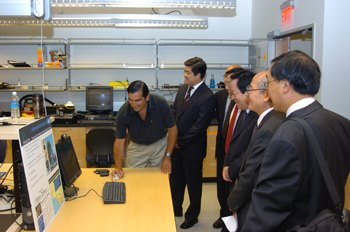New Wireless Devices Could Help Consumers Keep Track of their Vital Signs
By Doug Ramsey, 858-822-5825, dramsey@ucsd.edu
San Diego, CA, December 20, 2007 -- Forget about videogames or driving directions. Paul Blair thinks the next 'killer' mobile applications will be for monitoring your health. The Calit2 staff researcher should know; he is working on a range of devices that use wireless technology as well as smaller and cheaper sensors to track people's vital signs on a daily, even hourly, basis. The data can then be automatically uploaded to a database accessible via the Internet.
|
There, the individual and his or her physician, family members or caregivers could keep track of factors such as blood pressure, heart rate, activity levels, weight, and so on.
"You can't go into your local drugstore and get this stuff," says Blair. "It's neglectful that we aren't able to easily aggregatevital data such as blood pressure or heart rate, and to learn from prior data how to modulate our activities or diet to improve our health going forward. Think about it: We do that with our financial health, by looking at how our stocks or property did last year, but we can't do it with our physical health!"
Yet today, most of the technology is within reach. "Our goal is to make collecting this data as unobtrusive as possible," notes the researcher.
"Adapting wireless and sensor technologies for use in medical research is now a prime area of investigation within Calit2," confirms Philip Rios, another staff researcher in the UCSD division, who is leading the development of a software infrastructure and web interface for the TeleHealth Wireless Home Monitoring system. He works on the software, while Blair has primary responsibility for designing the devices and protocols that will feed data into the TeleHealth system.
The software team led by Rios is designing the web portal for two primary user communities: patients who want to keep track of their vital signs, and physicians who require more detailed views of the data. Rios sees a variety of data eventually being fed wirelessly into the TeleHealth system, including heart rate, activity rate, glucose, blood-oxygen levels and so on.
|
Working with Calit2 staff researchers as well as teams of students in ECE 191-the Electrical and Computer Engineering department's senior design course-Blair has been able to develop prototypes for a wireless-equipped blood pressure monitor and a bathroom weight scale.
The blood-pressure monitor includes a Bluetoothinterface for sending the latest reading to a nearby phone capable of data transmission. At routine intervals, the phone automatically uploads the information to a central database via the phone's 3G wireless transmitter.
Blair has also developed a high-tech bathroom scale that automatically records the patient's weight and timestamps the data, which is stored in the scale's memory, capable of holding up to six months of data. What makes this scale unique is that it allows the patient to upload the data seamlessly to a Bluetooth-enabled cell phone for subsequent transmission to a data repository accessible via the Internet. According to Blair, the scale is ready to be mass produced, and he is talking with UCSD tech-transfer officials about how to commercialize the technology.
The project grew out of research in the UCSD School of Medicine which found that dieters are more successful at losing weight if they weigh themselves daily and keep track of losses and gains. Yet many dieters in such studies are less than diligent about reporting their weight, and Blair says the wireless-enabled home scale makes reporting weight a breeze.
|
Blair now has a group of students working on a heart rate monitor that would also track heart rate variability. Another project involves an activity assessment monitor with a three-axis accelerometer and Bluetooth; he believes it could sell for $40 or less.
Indeed, Blair says that a major obstacle to widespread adoption is the relatively high cost of existing monitors on the market. "My focus is to break down the cost barriers to widespread use of these health monitors," says Blair. "There is no reason why we cannot reduce the cost of blood pressure monitors to below $100 even as we add Bluetooth and other functions." Blair notes that consumers are more than willing to spend $100 on a high-tech toothbrush and hypothesizes that they should be willing to invest the same amount in a health monitoring device that could help ensure their health and longevity.
Blair believes his devices and the TeleHealth monitoring system will allow people to live at home longer -- so-called "aging in place" -- and permit them to be more active. The reason: the wireless component allows people to be monitored from anywhere-the park around the block or one around the world.
"People should be aware of the data on their resting heart rate, their blood pressure and other barometers of health," emphasizes Blair. But not only because an anomalous reading likely indicates the need for investigation by their physician. Blair argues that people are much more likely to stick with lifestyle or wellness changes if they can see graphically, for instance, how a New Year's resolution to workout more is having a positive impact on their weight, blood pressure and so on
But above all, concludes Blair, the TeleHealth monitoring system and devices have the potential to save many lives: "Our software will allow people to set alarms, so they can more quickly see health problems coming, rather than the current paradigm-where we often don't notice a problem until we end up in the emergency room."
Related Links
Enhanced Bluetooth Blood Pressure Monitor Project Description
Wireless Bathroom Scale Project Description




